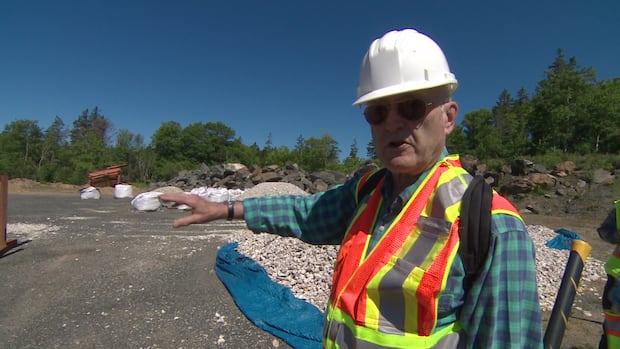Nova Scotia·NewMembers of Nova Scotia’s critical minerals industry are celebrating the federal government’s new budget that would see extra attention and resources for the sector, but one environmental advocate is urging caution.Nova Scotia’s industry welcomes federal funding as Ecology Action Centre urges cautionListen to this articleEstimated 4 minutesThe audio version of this article is generated by text-to-speech, a technology based on artificial intelligence.John Wightman, managing director of the Goldfields Group of Companies, stands in front of crushed pegmatite in this file photo from 2016. (CBC)Members of Nova Scotia’s critical minerals industry are celebrating the federal government’s new budget that would see extra attention and resources for the sector, but one environmental advocate is urging caution. John Wightman, managing director of the Goldfields Group of Companies, has spent decades in the industry as a prospector and geologist.For him, getting early-stage investments for exploration and development has always been difficult, so he sees Ottawa’s commitment to critical minerals as a good thing. “It’s very, very positive for the industry to help us develop new mines,” Wightman said. The federal budget, which passed on Monday, introduced a $2-billion “critical minerals sovereign fund” and a $371.8-million “first and last mile fund,” both of which will support development projects.The budget also expands tax credit eligibility for 12 additional minerals, which means 17 out of Nova Scotia’s 20 critical minerals will be included.Janice Zinck, executive director of Geoscience and Mines for the province, says the expanded federal support aligns with Nova Scotia’s push to develop its own industry.“It really helps to raise capital for the development of those projects and allows industry to be able to advance by attracting investors to their projects,” she said. However, Karen McKendry, the senior wilderness outreach co-ordinator with the Ecology Action Centre, says that while some critical minerals are necessary to have more renewable energy, she also says “we can’t mine our way out of the climate crisis.”Tellurium, shown at the Rio Tinto Kennecott refinery in Magna, Utah, is one of Nova Scotia’s critical minerals. It can be used for solar panels and thermoelectric devices. (Rick Bowmer/The Associated Press)What are critical mineralsCritical minerals refers to a group of elements used in modern technology to make items like batteries, solar panels and cellphones. These elements include lithium, copper and uranium, which was recently added to Nova Scotia’s list of critical minerals after a 15-year ban.Zinck says there are over 20 critical-mineral projects underway in the province, all in different stages of development.She hopes this push from Ottawa will benefit those projects. “The federal budget will really help to be able to attract investment to those projects and help to move them towards production,” said Zinck. “This is a good news story for the province.”Wightman adds that due to the current tensions between the U.S. and Canada, it’s more important than ever to be self-reliant.“If we’re going to have those attributes to our society, then we have to pay a price. You can’t just rely on others to provide those materials,” he said. Environmental concerns remainMining projects in Nova Scotia have faced some pushback from people across the province in recent months, as the province looks at more resource development.Residents in Coxheath Hills, near Sydney, expressed concerns that a proposed copper mine could damage local ecosystems and contaminate their drinking water supply.Last month, a group of Nova Scotians brought their concerns about the uranium ban being lifted — and a petition with 7,000 signatures — to Province House. Some had concerns about potential development reducing property values and harming water supply health if something were to go wrong.McKendry with the Ecology Action Centre says all mining has an effect on the environment, and while some of it is necessary to support a transition into renewable energy, blanket support for more mines from governments is not a total solution. “We’re going to be needing to do research and development on less impactful batteries that use other things that are more common and less destructive on Earth,” she said. Lithium, which is one of Nova Scotia’s critical minerals, can be used to make lithium-ion batteries and charging banks. (Shutterstock)McKendry says the best approach would prioritize select projects that responsibly extract the critical minerals needed for the transition to clean energy. But as it stands, she says, the federal budget offers broad support to all critical-mineral projects, regardless of how the minerals will ultimately be used. “We won’t get to see who the minerals are sold to or what they’re used for,” she said, pointing to the proposed tungsten mine in New Brunswick.“Tungsten is used in bullets. Bullets are not part of the low-carbon economy we’re trying to build,” she said. “So we can’t guarantee that mining something in Canada will mean it’s used for the purposes we want.”MORE TOP STORIESABOUT THE AUTHORGiuliana is a journalist originally from Lima, Peru. She is interested in stories about rural Nova Scotia, science, the environment and more. If you have any story tips, you can reach her at giuliana.grillo.de.lambarri@cbc.ca.
Ottawa’s support of critical mineral development sparks optimism, skepticism












